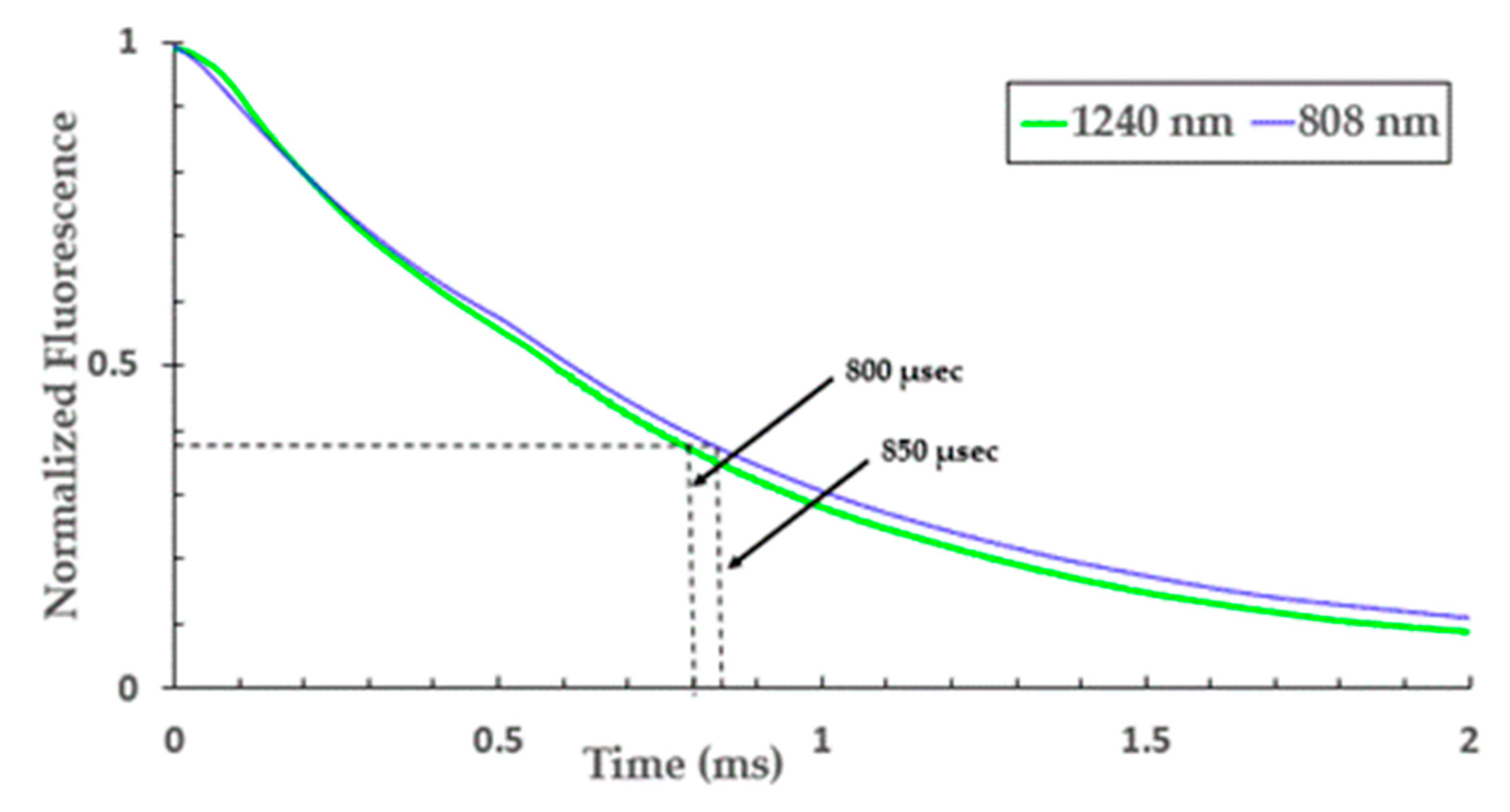Optical Characterisations of Bi-Phosphosilicate Fiber for O Band Amplification
Abstract
:1. Introduction
2. Materials and Methods
2.1. Bismuth Doped Fiber Fabrication
2.2. Bi-Doped Fiber Optical Characterisations
3. Results and Discussion
Bismuth-Doped Fiber Amplifier (BDFA)
4. Conclusions
Author Contributions
Funding
Acknowledgments
Conflicts of Interest
References
- Dvoyrin, V.V.; Mashinsky, V.M.; Dianov, E.M.; Umnikov, E.E.; Yashkov, M.V.; Guryanov, A.N. Absorption, Fluorescence and Optical Amplification in MCVD Bismuth-doped Silica Glass Optical Fibres. In Proceedings of the 31st European Conference on Optical Communication (ECOC), Glasgow, UK, 25–29 September 2005; pp. 949–950. [Google Scholar]
- Firstov, S.V.; Khegai, A.M.; Kharakhordin, A.V.; Alyshev, S.V.; Firstova, E.G.; Ososkov, Y.J.; Melkumov, M.A.; Ishakova, L.D.; Evlampieva, E.B.; Lobanov, A.S.; et al. Compact and Efficient O-band Bismuth-doped Phosphosilicate Fiber Amplifier for Fiber-Optic Communications. Nat. Sci. Rep. 2020, 10, 11347. [Google Scholar] [CrossRef]
- Ahmad, H.; Samion, M.Z.; Kamely, A.A.; Wang, S.; Wang, Y.; Sahu, J.K. Multiwavelength Brillouin Generation in Bismuth-doped Fiber Laser with Single-and Double-Frequency Spacing. J. Lightwave Technol. 2020, 1. [Google Scholar] [CrossRef]
- Haruna, T.; Kakui, M.; Taru, T.; Ishikawa, S.H.; Onishi, M. Silica-Based Bismuth-Doped Fiber for Ultra Broad Band Light-Source and Optical Amplification around 1.1 μm. In Proceedings of the Optical Amplifiers and their Application Topical Meeting, Budapest, Hungary, 7–10 August 2005. paper MC3. [Google Scholar]
- Bufetov, I.A.; Melkumov, M.A.; Firstov, S.V.; Riumkin, K.E.; Shubin, A.V.; Khopin, V.F.; Guryanov, A.N.; Dianov, E.M. Bi-doped Optical Fiber and Fiber Lasers. IEEE J. Sel. Top. Quantum Electron. 2014, 20, 111–125. [Google Scholar] [CrossRef]
- Melkumov, M.A.; Alyshev, S.V.; Firstov, S.V.; Dianov, E.M. Bismuth-doped Fiber Lasers and Amplifiers: Review and Prospects. In Proceedings of the IEEE International Conference Laser Optics (LO), St. Petersburg, Russia, 27 June–1 July 2016; pp. S1–S19. [Google Scholar]
- Kalita, M.P.; Yoo, S.; Sahu, J.K. Bismuth Doped Fiber Laser and Study of Unsaturable Loss and Pump Induced Absorption in Laser Performance. Opt. Express 2008, 16, 21032–21038. [Google Scholar] [CrossRef] [PubMed]
- Thipparapu, N.K.; Umnikov, A.A.; Barua, P.; Sahu, J.K. Bi-doped fiber amplifier with a flat gain of 25 dB operating in the wavelength band 1320–1360 nm. Opt. Lett. 2016, 41, 1518–1521. [Google Scholar] [CrossRef]
- Kalita, M.P.; Yoo, S.; Sahu, J.K. Influence of Cooling on a Bismuth-doped Fiber Laser and Amplifier Performance. Appl. Opt. 2009, 48, g83. [Google Scholar] [CrossRef] [PubMed]
- Mansoor, A.; Omar, N.Y.; Dambul, K.D.; Abdul Rashid, H.A.; Yusoff, Z. Fabrication and Characterization of a Bismuth-doped Fiber with Phosphorus. In Proceedings of the 7th IEEE International Conference on Photonics (ICP), Langkawi, Malaysia, 9–11 April 2018. [Google Scholar]
- Dissayanake, K.P.W.; Abdul Rashid, H.A.; Safei, A.; Oresegun, A.; Shahrizan, N.; Omar, N.Y.; Yusoff, Z.; Zulkifli, M.I.; Muhammad-Yassin, S.Z.; Mat-Sharif, K.A.; et al. Fabrication and Characterization of a Gallium co-doped Erbium Optical Fiber. In Proceedings of the 5th of IEEE International Conference on Photonics (ICP), Kuala Lumpur, Malaysia, 2–4 September 2014. [Google Scholar]
- Zhao, Q.; Luo, Y.; Wei, S.; Peng, G.D. Investigation of Unsaturable Absorption and Excited State Absorption on Bi/Er Co-doped Fibers. In Proceedings of the Photonics and Fiber Technology Congress, Sydney, Australia, 5–8 September 2016. [Google Scholar]
- Firstov, S.V.; Khopin, V.F.; Afanas’ev, F.V.; Khegai, A.M.; Alyshev, S.V.; Riumkin, K.E.; Vechkanov, N.N.; Abramov, A.N.; Melkumov, M.A.; Guryanov, A.N.; et al. Unsaturable Absorption in Various Bi-doped Optical Fibers. In Proceedings of the Annual International Laser Physics Workshops (LPHYS), Kazan, Russia, 21–27 July 2017; p. S8.3.2. [Google Scholar]
- Cajzl, J.; Peterka, P.; Kowalczyk, M.; Tarka, J.; Sobon, G.; Sotor, J.; Aubrecht, J.; Honzátko, P.; Kašík, I. Thulium-doped Silica Fibers with Enhanced Fluorescence Lifetime and Their Application in Ultrafast Fiber Lasers. Fibers 2018, 6, 66. [Google Scholar] [CrossRef] [Green Version]
- Firstov, S.V.; Bufetov, I.A.; Khopin, V.F.; Shubin, A.V.; Smirnov, A.M.; Ishakova, L.D.; Vechkanov, N.N.; Guryanov, A.N.; Dianov, E.M. 2W Bismuth Doped Fiber Lasers in the Wavelength Range 1300–1500 nm and Variation of Bi-doped Fiber Parameters with Core Composition. Laser Phys. Lett. 2009, 6, 665–670. [Google Scholar] [CrossRef]
- Seo, Y.S.; Lim, C.; Fujimoto, Y.; Nakatsuka, M. 9.6 dB Gain at a 1310 nm Wavelength for a Bismuth-doped Fiber Amplifier. J. Opt. Soc. Korea 2007, 11, 63–66. [Google Scholar] [CrossRef]
- Norizan, S.F.; Chong, W.Y.; Harun, S.W.; Ahmad, H. O-band Bismuth-doped Fiber Amplifier with Double-Pass Configuration. IEEE Photonics Technol. Lett. 2011, 23, 1860–1862. [Google Scholar] [CrossRef]
- Dianov, E.M.; Firstov, S.V.; Medvedkov, O.I.; Bufetov, I.A. Luminescence and Laser Generation in Bi-doped Fibers in a Spectral Region of 1300-1520nm. In Proceedings of the IEEE Conference on Optical Fiber Communication, San Diego, CA, USA, 22–26 March 2009. [Google Scholar]
- Khegai, A.M.; Afanasiev, F.V.; Ososkov, Y.; Riumkin, K.E.; Khopin, V.F.; Lobanov, A.; Yashkov, M.Y.; Firstova, E.; Abramov, A.N.; Melkumov, M.; et al. The influence of the MCVD Process Parameters on the Optical Properties of Bismuth-doped Phosphosilicate Fibers. J. Lightwave Technol. 2020, 38, 6114–6120. [Google Scholar] [CrossRef]









Publisher’s Note: MDPI stays neutral with regard to jurisdictional claims in published maps and institutional affiliations. |
© 2020 by the authors. Licensee MDPI, Basel, Switzerland. This article is an open access article distributed under the terms and conditions of the Creative Commons Attribution (CC BY) license (http://creativecommons.org/licenses/by/4.0/).
Share and Cite
Mansoor, A.; Omar, N.Y.M.; Dambul, K.D.; Abdul-Rashid, H.A.; Yusoff, Z. Optical Characterisations of Bi-Phosphosilicate Fiber for O Band Amplification. Fibers 2020, 8, 76. https://doi.org/10.3390/fib8120076
Mansoor A, Omar NYM, Dambul KD, Abdul-Rashid HA, Yusoff Z. Optical Characterisations of Bi-Phosphosilicate Fiber for O Band Amplification. Fibers. 2020; 8(12):76. https://doi.org/10.3390/fib8120076
Chicago/Turabian StyleMansoor, Amilia, Nasr Y. M. Omar, Katrina D. Dambul, Hairul Azhar Abdul-Rashid, and Zulfadzli Yusoff. 2020. "Optical Characterisations of Bi-Phosphosilicate Fiber for O Band Amplification" Fibers 8, no. 12: 76. https://doi.org/10.3390/fib8120076





